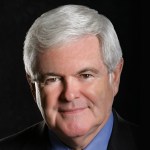In late February, a historic event occurred on the moon. An American vehicle, for the first time in 51 years, landed on the moon. Not since Apollo 17 have the Americans been back on the moon. Equally amazing, this new vehicle, a moon lander, was in fact at the South Pole. No American vehicle had ever gone to the South Pole. And that’s important, because you see a different part of space and the moon in the South Pole, area is different, has a lot more water, and has a lot of other interesting factors that we’ve been fascinated by, but haven’t been able to get to.
In many ways, the Odysseus lunar lander is a tribute to President Donald J. Trump, who decided when he came into office that we needed to reestablish the dynamic entrepreneurial spirit, the sense of adventure and excitement that President John F. Kennedy had created at Rice University in 1962, when he announced that we would put a man on the moon inside the decade. And we did that. [His] speech [was] in 1962. Seven years later, we had landed a man on the moon.
And we’re off and running now, with private sector entrepreneurs, like Elon Musk, and Cam [sic] for seeing a whole new level of energy, a new level of drive, and, frankly, a lot more money, because they bring their resources to match up with the government’s resources, and Intuitive Machines, which is the company that built the lunar lander, is part of a series including axiom space, which are working to develop a whole series of private sector opportunities, including the first commercial space station.
Why does this all matter? Because with Musk’s contribution in developing something which Congressman Bob Walker and I had worked on years ago, and that is a reusable rocket, one that could come back down, be used over and over again, [the] feeling now is that some of SpaceX’s rockets may get used 10 to 20 times before they have to be replaced. The drop in cost has been phenomenal. We now do about 10% of the price that we had before Elon Musk came along. And when his starship has developed, which will have 36 rocket engines, it’s going to be the most powerful rocket ever built, and it’s being designed to be reusable. So again, you’re gonna get into constant motion, much lower cost, much greater lifting capacity. And we’re at the beginning of a new era. And that’s why it was exciting to see us go back to the moon, and to know that people are going to follow.
The current plan is by 2025 or 2026, we’ll have the first team landing on the moon again. And this time, we’re going to be on the moon to stay, not just to visit briefly, not just to explore, but to actually begin building a capacity, starting with the kind of station we have in Antarctica, self-contained, available for scientists, gradually expanding, and then becoming ultimately a launching point for learning how we can go to Mars. I think this is an exciting time, and I hope you find it as interesting as I do.
















Newt Gingrich
Former House Speaker; Chairman of Gingrich 360
Commentary
Our commentary partners will help you reach your own conclusions on complex topics.
Is the US looking for a war?
7 hrs ago
Peter Zeihan
How future generations could shift US support for Israel
Yesterday
Peter Zeihan
Why election of European Commission president is so important
Wednesday
Peter Zeihan
‘Both completely corrupt’: What Americans think of Biden, Trump
Tuesday
Dr. Frank Luntz
SpaceX, Intuitive Machines herald a new space age
Newt Gingrich
Former House Speaker; Chairman of Gingrich 360
By Straight Arrow News
On Feb. 22, the lunar rover Odysseus made history as the first commercial space vehicle to accomplish a soft landing on the moon. The achievement is also a hallmark of the increasing privatization of space exploration and future space travel, with private companies like SpaceX and Intuitive Machines playing key roles alongside federal governments.
Straight Arrow News contributor Newt Gingrich welcomes these developments and says that they herald an exciting new age of space travel and exploration. Gingrich indicates that private companies might even dream of putting a man on Mars in the years ahead.
Why does this all matter? Because with Musk’s contribution in developing something which Congressman Bob Walker and I had worked on years ago, and — that is — a reusable rocket, one that could come back down, be used over and over again, [the] feeling now is that some of SpaceX’s rockets may get used 10 to 20 times before they have to be replaced.
The drop in cost has been phenomenal. We now do about 10% of the price that we had before Elon Musk came along. And when his Starship is developed, which will have 36 rocket engines, it’s going to be the most powerful rocket ever built, and it’s being designed to be reusable. So again, you’re gonna get into constant motion, much lower cost, much greater lifting capacity. And we’re at the beginning of a new era. And that’s why it was exciting to see us go back to the moon and to know that people are going to follow.
The current plan is by 2025 or 2026, we’ll have the first team landing on the moon again. And this time, we’re going to be on the moon to stay, not just to visit briefly, not just to explore, but to actually begin building a capacity, starting with the kind of station we have in Antarctica, self-contained, available for scientists, gradually expanding, and then becoming ultimately a launching point for learning how we can go to Mars. I think this is an exciting time, and I hope you find it as interesting as I do.
In late February, a historic event occurred on the moon. An American vehicle, for the first time in 51 years, landed on the moon. Not since Apollo 17 have the Americans been back on the moon. Equally amazing, this new vehicle, a moon lander, was in fact at the South Pole. No American vehicle had ever gone to the South Pole. And that’s important, because you see a different part of space and the moon in the South Pole, area is different, has a lot more water, and has a lot of other interesting factors that we’ve been fascinated by, but haven’t been able to get to.
In many ways, the Odysseus lunar lander is a tribute to President Donald J. Trump, who decided when he came into office that we needed to reestablish the dynamic entrepreneurial spirit, the sense of adventure and excitement that President John F. Kennedy had created at Rice University in 1962, when he announced that we would put a man on the moon inside the decade. And we did that. [His] speech [was] in 1962. Seven years later, we had landed a man on the moon.
And we’re off and running now, with private sector entrepreneurs, like Elon Musk, and Cam [sic] for seeing a whole new level of energy, a new level of drive, and, frankly, a lot more money, because they bring their resources to match up with the government’s resources, and Intuitive Machines, which is the company that built the lunar lander, is part of a series including axiom space, which are working to develop a whole series of private sector opportunities, including the first commercial space station.
Why does this all matter? Because with Musk’s contribution in developing something which Congressman Bob Walker and I had worked on years ago, and that is a reusable rocket, one that could come back down, be used over and over again, [the] feeling now is that some of SpaceX’s rockets may get used 10 to 20 times before they have to be replaced. The drop in cost has been phenomenal. We now do about 10% of the price that we had before Elon Musk came along. And when his starship has developed, which will have 36 rocket engines, it’s going to be the most powerful rocket ever built, and it’s being designed to be reusable. So again, you’re gonna get into constant motion, much lower cost, much greater lifting capacity. And we’re at the beginning of a new era. And that’s why it was exciting to see us go back to the moon, and to know that people are going to follow.
The current plan is by 2025 or 2026, we’ll have the first team landing on the moon again. And this time, we’re going to be on the moon to stay, not just to visit briefly, not just to explore, but to actually begin building a capacity, starting with the kind of station we have in Antarctica, self-contained, available for scientists, gradually expanding, and then becoming ultimately a launching point for learning how we can go to Mars. I think this is an exciting time, and I hope you find it as interesting as I do.
Why all the changes in European parliamentary governments?
It’s been a busy couple of months in Europe. The U.K. elected the Labour Party for the first time in well over a decade. In France, the New Popular Front (NFP), a Leftist coalition, which won the most seats in Parliament during the snap elections, announced its preferred candidate for prime minister: little-known civil servant…
Wednesday
Republican nominee Trump will reenergize the country
In one week, former President Donald Trump survived an assassination attempt, selected a vice presidential running mate and become the official Republican nominee for president. Trump is ramping up his campaign to challenge his likely opponent, incumbent President Joe Biden, in November. Watch the video above as Straight Arrow News contributor Newt Gingrich celebrates Trump,…
Jul 17
Pay close attention to both nominating conventions
The Republican National Convention will be held in Milwaukee from July 15 to 18, where former President Donald Trump is expected to be formally chosen as the party’s nominee for the 2024 election. The Democrats will gather in Chicago from Aug. 19 to 22, where Democratic leaders say they will reaffirm their support for President…
Jul 10
July 4 is a sacred holiday for all free people
On July 2, 1776, the Second Continental Congress voted unanimously in favor of American independence from Great Britain, and formally adopted the final text of the Declaration of Independence two days later. Americans today mark July 4 as a national holiday to commemorate their independence and celebrate their hard-earned victory in the Revolutionary War. Watch…
Jul 3
US should eliminate taxes on server tips
In the United States, restaurant servers are paid below minimum wage and earn the majority of their incomes from tips left by customers. Even after accounting for these tips, a 2015 analysis concluded that the total median hourly income for a server in the U.S. was just $13, while bartenders earned only $9. Former President…
Jun 26
Underreported stories from each side
Group accuses Pa. teachers union of illegally using money to back Shapiro’s 2022 campaign
8 sources | 0% from the left
Getty Images
Some House Republicans slam Vance as Trump’s VP pick: ‘The worst choice’
8 sources | 0% from the right
Reuters
Latest Stories
Congress still trying to figure out how to reduce wasteful military spending
Watch 2:29
2 hrs ago
US Navy, Air Force making waves with new weapons at RIMPAC
Watch 6:03
2 hrs ago
Israeli PM Netanyahu meets with Trump at Mar-a-Lago
Watch 2:54
2 hrs ago
Growing US nuclear power resurgence reaches the nation’s heartland
Watch 1:19
2 hrs ago
Beer from the sun, other solar thermal projects get government funding
Watch 2:04
3 hrs ago
Popular Opinions
In addition to the facts, we believe it’s vital to hear perspectives from all sides of the political spectrum.
Trump has an excellent opportunity with Black voters
8 hrs ago
Star Parker
Don’t fall for GOP’s cheap racist attacks on Kamala Harris
9 hrs ago
Dr. Rashad Richey
Americans must reject Trump to defend our democracy
Yesterday
Jordan Reid
Why all the changes in European parliamentary governments?
Wednesday
Newt Gingrich